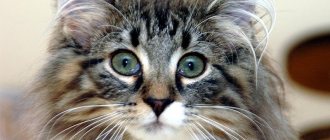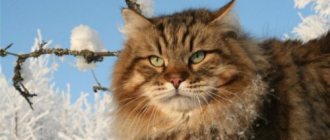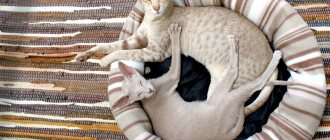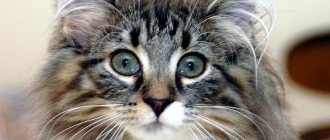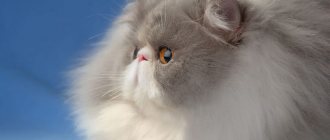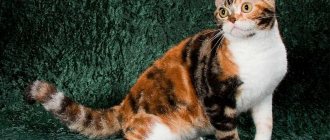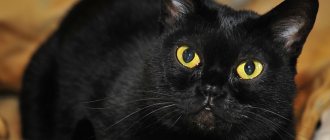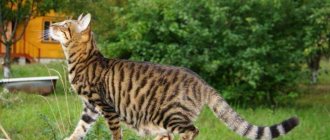Among domestic purrs, Maine Coons are considered to be the largest breed. The record holder for height among his own kind is a cat named Stewie, who grew to 123 centimeters. And in terms of weight, three-year-old Rupert is recognized as the leader, having already gained 9 kilograms at such a young age. And, as experts promise, this is not the limit for him. After all, the baby is still growing. In the future, Rupert has a good six kilograms.
Many of the giant domestic cat species are simply unknown. The owners do not advertise the parameters of their pets. However, among the happy owners of furry households the question is often asked: “Until what age do cats grow?”
The answer may have several options, since puberty occurs at one age, pets stop growing in length at another, but some continue to grow in breadth throughout their lives.
What determines the size of a cat? If your little brother hasn't gained the Maine Coon weight, don't be upset. Perhaps this is his breed. A Singapura cat, for example, rarely gains more than 3 kilograms in weight. Also, this breed produces offspring later, unlike others. This means that puberty occurs later.
How do the British grow up?
Let's look at the situation from the “British” side. The breed is loved by many. Plush kittens evoke affection, and their easy-going, unpretentious nature turns them into ideal family friends. They have short legs, amber eyes and many color variations. The British are credited with a high level of intelligence. A representative of this breed became the prototype of the famous Cheshire cat. They usually become sexually mature in the ninth month.
Veterinarians answer the question: “To what age do the British grow?” - they call the age 2-2.5 years. They imply the length of the animal’s body and the width of the “shoulders”. General formation ends at approximately 3 years of age. As for weight, an adult male can gain up to 8 kilograms, a castrated one - up to 10 kilograms, a female - up to 6, and a sterilized one - up to 8. But it would be wrong to consider this the norm for all British people. Many individual characteristics and conditions influence weight.
Growth and development of cats of different breeds
Cats of different breeds grow and mature in different ways.
Average weight of different cat breeds
- “Britons” emerge from adolescence by the age of three, while they acquire the ability to reproduce as early as 9 months. Adult males can weigh up to 8 kg, and castrated males can weigh up to 8 kg;
- Bengal kittens grow slowly during childhood. At the age of two years they are considered adults. Cats of this breed weigh 4-5 kg, and males - up to 7 kg;
- Maine Coons are born large when compared to kittens of other breeds. The first six months of life are a period of active growth. Due to the fact that the body becomes disproportionate, the young animal sometimes looks like an ugly duckling, but by the age of three it grows into a gorgeous handsome man. On average, a mature cat of this breed weighs 8-10 kg, and the length of its body with tail can be up to 1 m;
- Siberian cats are considered large pets, although they are slightly inferior to Maine Coons. The weight of an adult “Siberian” is from 6 to 9 kg, a cat is slightly smaller – from 3.5 to 7 kg. These animals grow slowly and mature only at the age of five;
Siberian cat
- Sphinxes are not large. Sexual maturity of hairless cats occurs at the end of the first year of life, and they are considered adults at the age of 2 years. The average weight of a Sphynx is 4 kg.
Sphinxes
As for cats of the “noble breed”, there are no standards. Animals have a mixed genotype, so they develop and grow depending on which genes of their ancestors turn out to be dominant. “Nobles” come in different sizes, and some representatives are catching up with Maine Coons, not inferior to them in beauty.
Top 8 largest domestic cats
Hormonal disbalance
How long it takes for cats to grow, you yourself will not be able to understand if your furry friend has a hormonal imbalance. This is a serious problem, due to which at a certain moment the animal’s body can stop developing for a period of up to several months, and after some time it can suddenly begin to grow. Motherhood sometimes saves girls. If your cat has stopped growing after giving birth and has not achieved the necessary parameters, consult a doctor. The problem can be quite serious.
“Mature” is how adult males are characterized. And they become like that by the age of three. But hormonal changes can also occur in cats. Especially if he survived castration surgery. Many people, when they see a large boy with sloping sides, assume that he will never become a “father of the family.” But here again everything is individual. To what age does a cat continue to grow? It takes longer for him to develop than the female. But one should not confuse the increase in his weight from abundant nutrition with development.
If you have the opportunity to see your purr's parents, you can imagine what she will look like as an adult. And therefore you can understand when your cat or kitty has grown up. Further changes that will occur in appearance will depend only on how and what the animal eats. By the way, they say that a “brutal” appetite is characteristic precisely during the period of development. But it is not so. The pet’s adaptation to a certain diet also plays a role here.
You can always find out at what age cats grow at a consultation at a veterinary clinic. A specialist who knows the breed of your pet, is familiar with all the characteristics of the body, and keeps a history of its illness since childhood will be able to more accurately suggest when the peak of development will occur.
Growth concept
Physiological growth refers to the visual enlargement of the cat and the formation of internal systems. The body independently controls this process. A uniform and proportional increase in the torso, skull and limbs depends on the coherence of the thyroid gland, pituitary gland, adrenal glands, ovaries in females and testes in males.
Somatotropin, a peptide hormone synthesized in the pituitary gland, is of decisive importance for the harmonious maturation of mammals. It regulates the gradual increase in bones until the final formation of the skeleton. This process continues for up to one to one and a half years. Growth hormone production decreases when the cartilage plates become saturated with minerals and become ossified. After this, it controls muscle building and helps improve metabolism.
Before the formation of the genital organs, the development of the kitten is assessed by weight gain. Then this indicator becomes inaccurate, body weight sometimes increases due to obesity.
The completion of formation is signaled by the constancy of the following dimensions:
- length and width of the torso and limbs;
- distance between the blades;
- size and shape of the skull.
The age of final formation of the external appearance covers the range from 9 months to 3 years, and is individual for each individual. After the onset of physiological maturity, the pet does not change; the fat layer can increase its size when overeating.
Important factor
As already mentioned, the conditions of keeping cats and cats and their habitat play a big role. Street animals look very contrasting with their peers who are raised at home. It's not just the condition of the fur. The first thing that catches your eye is the parameters. After all, not every street distributes nutritious food and vitamins for cats. In addition, the immune system is weak, various sores can stick, affecting growth. But stray cats also get used to their living conditions. Therefore, if you adopt a cat from the street, do not rush to stuff it with delicacies. Weight is not an indicator of normal health. It’s better to include a vitamin complex in your diet, then your cat will be able to catch up with its peers in development without health consequences.
Kittens weight
After the baby is born, you can see how strong and big he will grow.
For a newborn British kitten, the normal weight is in the range of 70-130 g. Already in the second week, the kitten can reach a weight of 150 g. In two weeks, the baby grows almost one and a half times, which means that it is the first period of his life that will greatly influence the future sizes.
The main thing is to pay enough attention to nutrition. A cat that feeds growing offspring must be well fed with high-calorie food and vitamins in order to be able to fully feed the kittens with milk.
After the second week, the baby already weighs 210 g - this is the average. However, a kitten can weigh much more - 450 g (upper norm). He becomes more active, his eyes may even open.
At the end of the first month of life, complementary foods can be introduced. It is permissible to feed the baby with boiled and finely chopped beef and canned cat food, sea fish, chicken, cottage cheese (a very useful product for strengthening bones) and hard-boiled eggs (yolks only).
In the first month of development, the kitten should grow to 250 g, although a normal weight is even 600 g. Well, in two months, depending on heredity and nutrition, the kitten will weigh from 700 g to 1.5 kg.
Over the course of three months of life, the kitten must gain at least 1 kg of weight. If not, he may have a health problem or is not getting enough nutrition.
During this period, the kitten can become almost 100 g heavier every day. A cat at this age should weigh in the range of 1-1.5 kg, and a cat - 1.5-2 kg.
If babies are still fed breast milk, they need to introduce vitamins and a more varied diet into their diet. It is not recommended to give them smoked meats, pork and other fatty meats, fatty cottage cheese, river fish and, most importantly, meat with bones. The best option is canned cat food with a good range of vitamins and nutrients.
After 4 months of life, cats gain up to 1.7-2.4 kg, and males - from 2.1 to 3.9 kg. The pet becomes even more like an adult animal. If his weight exceeds 4 kg, it is necessary to reduce the amount of food, since a cat that begins to gain weight at an early age may have many health problems in the future. It may be worth contacting a veterinarian - he will prescribe the right diet and vitamins.
After five months of life, the male cat should weigh 2.6-4.5 kg, and the male cat should weigh 2.2-2.9 kg. Before becoming an adult cat, the pet will have to gain the same amount of mass.
At the sixth month of life, the kitten develops fairly strong teeth. Sexual development begins. It would also be a good idea to think about preventing worms. The quantity and food for kittens can be gradually reduced.
In the seventh month, the pet may shed hair, especially if it spends a lot of time outside. Hairballs appear everywhere, which the kittens regurgitate.
At the eighth month of a kitten’s life, the owner is faced with the question of whether to castrate/sterilize or not. It is better to carry out this procedure for cats at the 8th month, for cats no later than a year.
In the ninth month you need to get vaccinated. They are already sufficiently formed so that medication does not have a detrimental effect on them.
At the tenth month of life, food for adult cats should be introduced into the diet, and the children's menu should be abandoned. Now they can be given dry food.
At the age of 11-12 months of life, kittens begin to play actively, stop creating inconvenience for others and like to often release their claws. The weight of cats at one year of age and in adulthood is given below (castration/sterilization also plays a role).
Table
Reasons for slower growth
If an animal lives in a prosperous environment, eats a balanced diet, but suddenly stops developing, then it is better to contact a veterinarian.
Possible reasons for this are:
- Diseases: infectious, somatic, congenital, hidden. Any pathologies disrupt the functioning of internal organs and inhibit development.
- Helminths . Worms take away nutrients that come from food.
- Hormonal imbalance. Deviations from the norm occur due to uncontrolled use of hormone-containing drugs or internal failure.
- Early pregnancy (up to one year). Puberty in females occurs earlier than physical maturity. After the formation of the ovaries, the cat is able to become pregnant, but the body is not ready to bear offspring; this process takes away strength and slows down maturation.
- Stress. In a state of nervous tension, cats stop eating, do not receive enough nutrients and develop more slowly.
The age at which growth ceases is individual for each animal; it is determined by breed, heredity and gender. A person’s task is to avoid mistakes in maintenance and care, so as not to disrupt the laid down genetic program.
Stages of formation
The active growth phase in most cats lasts until the end of maturation, usually up to 10-15 months (depending on the breed). Representatives of large breeds (Maine Coons, Bengals, Servals, etc.) grow up to 2, and some up to 3 years.
The transformation of a kitten into an adult occurs in several stages. It is very important that favorable conditions are created at each of them, otherwise this will lead to irreversible consequences: stunting, size discrepancy, health problems, etc.
- Neonatal. Lasts several days from the moment the animal is born. During this period, as a rule, most babies lose weight.
- Sucker. It lasts 3-3.5 weeks, during which the kitten steadily gains weight and grows.
- Transition. Period from 4 to 6 weeks. It is characterized by not as active growth as in the first weeks, but after that, if all conditions are created for this, the baby continues to increase in size.
- Adolescent – age from 2 months until the end of development (depending on the breed). The peak is observed in the period of 3-5 months. By the end of this stage, cats stop growing, but cats can only increase by 2-3 centimeters.
Up to a year, cats grow in length and width, then in breadth, gaining weight characteristic of their breed.

